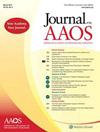Impact of Extended Prophylactic Antibiotics on Risk of Prosthetic Joint Infection in Primary Total Hip Arthroplasty: A Matched Cohort Analysis.
IF 2.6
2区 医学
Q1 ORTHOPEDICS
Journal of the American Academy of Orthopaedic Surgeons
Pub Date : 2024-09-10
DOI:10.5435/jaaos-d-24-00290
引用次数: 0
Abstract
BACKGROUND Extended oral prophylactic antibiotics have been increasingly used in arthroplasty with the goal of reducing the risk of prosthetic joint infection (PJI). While a reduction in the rate of PJI has been noted with extended oral antibiotic regimens in high-risk patients, no large database study has assessed infection risk after primary total hip arthroplasty among well-balanced cohorts receiving and not receiving postoperative extended oral antibiotics. METHODS A retrospective cohort study was conducted using a national database, TriNetX, to identify patients who underwent primary total hip arthroplasty. This cohort was stratified by oral antibiotic prescription within one day of procedure. A one-to-one propensity score matching based on age, sex, class of obesity, and medical comorbidities was conducted. Outcomes explored in this study were 90-day risk of PJI, superficial skin infection, deep skin infection, and all-cause revision. RESULTS 90-day postoperative infection complications of PJI were higher in the group receiving antibiotics (hazard ratio: 1.83, P-value = 0.012). Other complications such as superficial skin infection, deep skin infection, and all-cause revision showed no statistically significant differences. CONCLUSION This database analysis of 5,476 patients demonstrated no decrease in complications of PJI, superficial or deep skin infection, or revision at 90 days. Future randomized controlled trials are needed to evaluate the efficacy of extended oral antibiotics. LEVEL OF EVIDENCE III.延长预防性抗生素对初次全髋关节置换术中人工关节感染风险的影响:匹配队列分析
背景在关节置换术中越来越多地使用延长口服预防性抗生素,目的是降低假体关节感染(PJI)的风险。虽然在高风险患者中使用延长口服抗生素方案可降低 PJI 的发生率,但还没有大型数据库研究对接受和未接受术后延长口服抗生素的均衡队列中的原发性全髋关节置换术后感染风险进行评估。根据术后一天内的口服抗生素处方对该队列进行了分层。根据年龄、性别、肥胖程度和合并症进行了一对一倾向得分匹配。结果 接受抗生素治疗组的术后 90 天 PJI 感染并发症发生率更高(危险比:1.83,P 值 = 0.012)。结论 这项对 5476 名患者进行的数据库分析表明,术后 90 天的 PJI、浅表或深层皮肤感染或翻修等并发症并未减少。未来需要进行随机对照试验,以评估延长口服抗生素的疗效。
本文章由计算机程序翻译,如有差异,请以英文原文为准。
求助全文
约1分钟内获得全文
求助全文
来源期刊
CiteScore
6.10
自引率
6.20%
发文量
529
审稿时长
4-8 weeks
期刊介绍:
The Journal of the American Academy of Orthopaedic Surgeons was established in the fall of 1993 by the Academy in response to its membership’s demand for a clinical review journal. Two issues were published the first year, followed by six issues yearly from 1994 through 2004. In September 2005, JAAOS began publishing monthly issues.
Each issue includes richly illustrated peer-reviewed articles focused on clinical diagnosis and management. Special features in each issue provide commentary on developments in pharmacotherapeutics, materials and techniques, and computer applications.

 求助内容:
求助内容: 应助结果提醒方式:
应助结果提醒方式:


